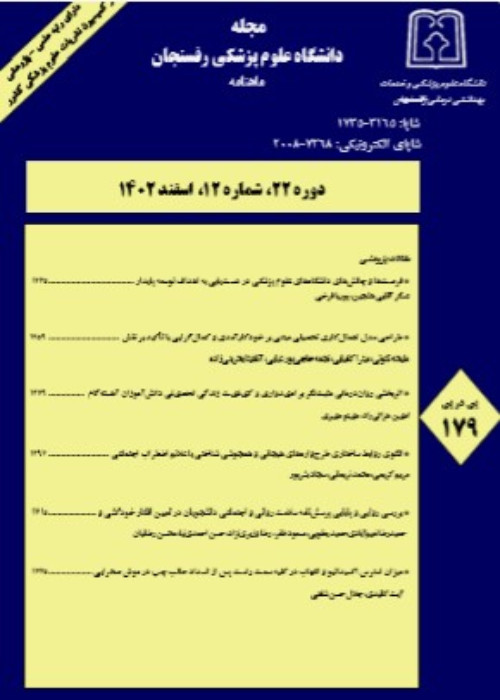Removal of Green 6 Direct Dye from Aqueous Solutions Using Immobilized Laccase Enzyme on Zinc Ferrite Nanoparticle
Author(s):
Article Type:
Research/Original Article (دارای رتبه معتبر)
Abstract:
Background And Objective
Manufactured wastewater management of industrial units containing toxic pollutants is essential for environmental protection. Considering the great applications and effects of using the nanomaterial and nanotechnology in the field of environmental protection, the nanoparticle of ZnFe2O4 has been used as a basic particle. On the other hand, enzyme processes, due to their low costs and cheapness, can be used as the new and efficient processes for decolorization from wastewater. Therefore, the aim of this study was to evaluate the efficiency of removal of green 6 direct dyes from aqueous solutions using immobilized laccase enzyme on zinc ferrite nanoparticle.Materials And Methods
First, the magnetic zinc ferrite nanoparticles (ZnFe2O4) were synthesized using sol-gel method. Then, by immobilizing laccase enzyme onto it and enzyme activation of the nanoparticles, it was used to remove green 6 direct dye from the aqueous solution. Long-life catalytic converters have been used to immobilize the enzyme on the surface of nanoparticles. In order to study the physical properties of the synthesized nanoparticles, Fourier-transform infrared spectroscopy (FTIR), X-ray diffraction (XRD) pattern and scanning electron microscopy (SEM) were used. The investigated conditions included contact time (120-160 minutes), adsorbent dosage )0.1-1mg/l(, pH (3,4,7,8,9) and initial color concentration (10 to 100 mg /l).Results
The results of the study showed a spherical and even crystalline structure of the enzymatic nanoparticles, with an average size of approximately equal to 23 to 40 nm. Photometric studies of the immobilized enzyme on zinc nanoparticle (IZFN) spectra at 1199, 1284, 2956 and 1714 peaks confirmed the CH2 group of triethoxymethylsilane, the peptide bond c = o group, as well as the S = O and C-N groups of the SO group in the Lacas enzyme. Therefore, the nanoscale composition of the enzyme immobilizing layers was confirmed. The maximum removal of color was 95% with the adsorbent dose of 0.2 mg/L, at the initial concentration of 10 mg /L, pH = 3.4 and the contact time of 120 minutesConclusion
The combination of the immobilized enzyme layers made in this study with immobilized enzyme on zinc nanoparticle can be a suitable adsorbent for the removal of dye contamination, especially the green 6 direct dyes from fabric dyeing wastewaters, as compared to the other similar nanoparticles.Language:
Persian
Published:
Journal of Rafsanjan University Of Medical Sciences, Volume:16 Issue: 9, 2018
Pages:
857 to 868
magiran.com/p1788894
دانلود و مطالعه متن این مقاله با یکی از روشهای زیر امکان پذیر است:
اشتراک شخصی
با عضویت و پرداخت آنلاین حق اشتراک یکساله به مبلغ 1,390,000ريال میتوانید 70 عنوان مطلب دانلود کنید!
اشتراک سازمانی
به کتابخانه دانشگاه یا محل کار خود پیشنهاد کنید تا اشتراک سازمانی این پایگاه را برای دسترسی نامحدود همه کاربران به متن مطالب تهیه نمایند!
توجه!
- حق عضویت دریافتی صرف حمایت از نشریات عضو و نگهداری، تکمیل و توسعه مگیران میشود.
- پرداخت حق اشتراک و دانلود مقالات اجازه بازنشر آن در سایر رسانههای چاپی و دیجیتال را به کاربر نمیدهد.
In order to view content subscription is required
Personal subscription
Subscribe magiran.com for 70 € euros via PayPal and download 70 articles during a year.
Organization subscription
Please contact us to subscribe your university or library for unlimited access!


